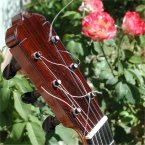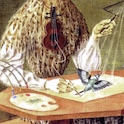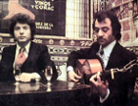Welcome to one of the most active flamenco sites on the Internet. Guests can read most posts but if you want to participate click here to register.
This site is dedicated to the memory of Paco de Lucía, Ron Mitchell, Guy Williams, Linda Elvira, Philip John Lee, Craig Eros, Ben Woods, David Serva and Tom Blackshear who went ahead of us.
We receive 12,200 visitors a month from 200 countries and 1.7 million page impressions a year. To advertise on this site please contact us.
|

|
|
Pulgar revisited
|
You are logged in as Guest
|
|
Users viewing this topic: none
|
|
Login  | |
|

   
greeny
Posts: 50
Joined: Feb. 26 2008

|
 Pulgar revisited Pulgar revisited
|
|
|
Hi everybody!
While still concentrating on developing some pulgar chops I've just discovered a nice little formula which seems to open up some avenues for me - thought I'd pass it on to you all in the hope it might benefit someone, somehow.
The basic idea is to use the pulgar and ONLY the pulgar on (and in an even) group of eight notes. They can be of any type of duration: eighths, sixteenths, thirty-seconds or simple quarter notes for that matter, but the important aspect to remember is that they are all - all the 8 notes - of equal length (duration).
The pulgar's movement in this exercice goes both ways - down and up.
Now the specific quality of the following exercice lies within the actual GROUPING of the down and upstrokes performed by the pulgar. In this case the group of eight note's stokes is subdivided into three small groups.
The formula is: 3 - 3 - 2.
Translated into pulgar stroke directions: Down, up, down,(3) Down, up, down,(3) Down, up.(2) Recognize the grouping's structure? 3-3-2?
OK, Now comes the actual trick.
Maintain the pulgar stroke-directions, do not vary them (yet!); down,up, down, down, up, down, down, up..... but mentally REGROUP the eight notes into two four-note groups of of equal length; (simply said divide 8 by 2) careful, because by playing the sequence and accenting the halfway points you now get:
Down, up, down, down, Up, down, down, up .... (Loop it to get into the groove and place an accent at the two halfway points)..... Like in a two-feel kinda thing, Rumba or what have you....?
All in all it's a little different feel than straight up and down or doing the standard Alzapua formula of down-down-up played continuously even if it's done in a duple meter kind of thing.
What to do with the formula?
I like to do four extra variations while keeping the stroke-directions formula intact because the formula should always remain the same! - Down-up-down-down-Up-down-down-up while observing the symetrical accents!
Step 1) On a single string, on a single note perform the above formula, keeping the forearm lose, with only the pulgar. Do the same with small and large chords. The Pulgar sure is loud!
Step 2) On a single string varying the note (different pitch) at the halfway point of the formula; ie: on the sixth string third fret G-G-G-G then fifth fret A-A-A-A so that it sounds like : looped : G G G G A A A A - Notice the first of the A notes is an upstroke. Also do with chords.
Step 3) On one or more strings sub-divide the pulgar-strokes formula with four different pitches, say for instance G-G-A-A-Bb-Bb-A-A. and loop it. Chords maybe?
Step 4) Play a different pitch for every different pulgar stroke. For example: a scale going up to the octave (8 notes). Here's a pattern I like to get into when dealing with single notes - on a single string: G-A -G-Bb-A-Bb-G-A.
Declinate this pattern going up the scale : start on the next note of the scale, etc....
My own favorite scale right now is a Harmonic-Major scale - a regular major scale but with a flatted sixth. Works well with Flamenco, too!
May I also suggests two other formulas! Namely: 3-2-3 and 2-3-3 ..... As in the example above re-divide the group of 8 notes into two even groups of four maintaining the pulgar's picking directions - "3" stands for down-up-down and "2" stands for down-up. Now the picture is quite complete, I guess!
Well folks, I hope you haven't fallen asleep just yet, I know it's a bit of a long story but it is all meant to motivate you!!... It's actually a simple little piece of information I wished to share. I haven't invented it. In the mid-nineties I took two years of lessons with a classical Indian Sarod player from Calcutta. I have always admired the rhythmical articulations a musician like Ali Akbar Khan could draw upon, very similar to the scope of Flamenco masters. The Sarod is played with a large pointed pua (pick) called a Jawa and is made from a piece of coconut shell. Now, Koustuv Ray, my teacher has passed on to me a great amount of sarod picking techniques along with dozens of exercices and musical pieces. I've just recently been able to bring the two together: my new love for Flamenco, my beautiful new guitar and some of the Sarod music and techniques I had worked on long ago.The Indian name for this actual exercice with the Jawa (or the pulgar) is called Ekara which means One - as in a single note. It's one of the single note techniques used melodically in Sarod music. Today I don't own a Sarod anymore and my teacher has passed away, leaving me with only music - and various picking techniques, rhythms, scales, ideas on developing themes and melodies and ways to string them all up together...... in the Indian way!
Flamenco and Indian Music share common roots in my ears: principally improvisation.
Ok, my girl's on the phone and dinner is served - got to go! But please feel free to react or comment, dis or encourage....
Oléeey!
|
|
|
|
REPORT THIS POST AS INAPPROPRIATE |
Date Mar. 16 2008 19:35:27
 |
|

   
greeny
Posts: 50
Joined: Feb. 26 2008

|
 RE: Pulgar revisited (in reply to guitarbuddha) RE: Pulgar revisited (in reply to guitarbuddha)
|
|
|
Guitarbuddha - Question!
(quote) ...whenever there is a duple stroke.... what's a duple stroke? i up i down? or i up m up?
as opposed to, say, single or triple stroke? i down or, i down, i up, i down?
And just for checking we speak the same language: semiquaver is a sixteenth note, right? or is it not?
And, also I assume that, in the sequences you wrote, (iiimmmii and mmmiiimm) when dealing with 3 you actually play down up down and dealing with 2 you do a down up combination- or even the reverse of everything.
I'm not sure I've grasped it fully but with my limited understanding, translated into actual RH finger movement it already feels great and I'll look into it during todays practice session.
Getting there is where all the fun is!
So.... it's back to the drawing board!
A.
|
|
|
|
REPORT THIS POST AS INAPPROPRIATE |
Date Mar. 17 2008 7:08:25
 |
|

   
Ricardo
Posts: 14822
Joined: Dec. 14 2004
From: Washington DC

|
 RE: Pulgar revisited (in reply to greeny) RE: Pulgar revisited (in reply to greeny)
|
|
|
quote:
ORIGINAL: greeny
Guitarbuddha - Question!
(quote) ...whenever there is a duple stroke.... what's a duple stroke? i up i down? or i up m up?
as opposed to, say, single or triple stroke? i down or, i down, i up, i down?
And just for checking we speak the same language: semiquaver is a sixteenth note, right? or is it not?
And, also I assume that, in the sequences you wrote, (iiimmmii and mmmiiimm) when dealing with 3 you actually play down up down and dealing with 2 you do a down up combination- or even the reverse of everything.
I'm not sure I've grasped it fully but with my limited understanding, translated into actual RH finger movement it already feels great and I'll look into it during todays practice session.
Getting there is where all the fun is!
So.... it's back to the drawing board!
A.
In classical/flamenco guitar, we do rasgueado in 2 directions, but plucked notes, free (tirando) or rested (apoyando) are always in ONE direction only with fingers (unlike sitar say). The thumb reverse stroke is rare exception.
So I assume GB meant rest strokes with his iiimmmim....if not....WTF??? 
_____________________________
CD's and transcriptions available here:
www.ricardomarlow.com
|
|
|
|
REPORT THIS POST AS INAPPROPRIATE |
Date Mar. 18 2008 2:39:43
 |
|

   
greeny
Posts: 50
Joined: Feb. 26 2008

|
 RE: Pulgar revisited (in reply to guitarbuddha) RE: Pulgar revisited (in reply to guitarbuddha)
|
|
|
GuitarBuddha......Aaaargghhh!
I think you have rather complicated the matter, maybe, perhaps, who knows.... I'm sure YOU understood the whole point we're dicussing but many others now seem utterly confused. Your post is so chock-full of information it'll take me some time to digest it fully.
Hey Folks, there's nothing complicated going on here - it's easy and simple...
In this "book" >> a three (3) group is always = down-up-down
and, a two (2) group = down-up
so either > i-i-i-m-m-m-i-i
or p-p-p-p-p-p-p-p translated from sanskrit is and always is:
down up down down up down down up. Now that isn't so hard, is it?
Keep it easy >> just play chords. Once you get confortable do single notes ....melodies and such.
The most important thing to remember is to accent the halfway points, initially even exagerating them, especially the second one - the up stroke at halfway.
I had started by applying the formula to the pulgar, and that can be quite nice and make for an exotic groove .... but that which Guitarbuddha suggested....>> the same 3 3 2 thing but this time with the fingers (i and m) has got me freaked out - it's so F*** great! it's fabulous, it's what I've been looking for, completely, totally.... Even in reverse, mmm iii mm which I haven't tried yet, must be an absolute hit!
Beware things do get a lot tougher when doing "it" > 3 2 3 and 2 3 3, but still, it's a must do.
Thanks ! I'd never thought of doing that 332 thing with the fingers... today I'm flying!
G.
|
|
|
|
REPORT THIS POST AS INAPPROPRIATE |
Date Mar. 18 2008 17:08:45
 |
|

   
Ricardo
Posts: 14822
Joined: Dec. 14 2004
From: Washington DC

|
 RE: Pulgar revisited (in reply to greeny) RE: Pulgar revisited (in reply to greeny)
|
|
|
quote:
Keep it easy >> just play chords. Once you get confortable do single notes ....melodies and such.
OK before things get any more unclear, I need to say you need to understand the mechanics of the technique of strumming vs playing single notes, ON GUITAR WITH FINGERS NOT WITH A PICK, are quite different. Even playing pulgar, playing the single notes vs, alzapua vs actually strumming with the thumb can all be very different. The thumb just playing single notes can at times be only the thumb moving, sometimes the wrist must move (like when you use a pick) and at times the entire arm needs to move.
I understand the purpose you guys are illustrating is one more about learning rhythm control which is great, but the mechanics of guitar technique, specifically the flamenco techniques are real important, and the rhythm ideas you guys want CAN be applied, but with the idea of the actual techniques in mind. You can't just say "ok now apply same RH pattern to single notes..." after doing rasgueados! My advice is that one can get plenty of exercises from the music itself, taken in chunks.
Ricardo
_____________________________
CD's and transcriptions available here:
www.ricardomarlow.com
|
|
|
|
REPORT THIS POST AS INAPPROPRIATE |
Date Mar. 18 2008 20:06:55
 |
|

   
Ricardo
Posts: 14822
Joined: Dec. 14 2004
From: Washington DC

|
 RE: Pulgar revisited (in reply to guitarbuddha) RE: Pulgar revisited (in reply to guitarbuddha)
|
|
|
I did not miss your point GB, I was just trying to clearify it for Greeny since you guys seemed to think you were both on the same page, but really YOU WANTED REST STROKES for your pattern, specifically we see now m on E string, and i on B string, where as Greeny was thinking like a plectrum pattern for pulgar doing UP AN DOWN STROKES, thinking you meant the same for i and m.
I always understood what the POINT of your pattern was. I see now you wanted to really ADD IT UP with the alternations until you fill in all your "quavers" or however you want to call your subdivisions. Basically you could have just said "yes but add them up" to my last "?".
I hope Greeny gets it now. His point, the point of THIS thread, is more about UP AND DOWN Stroke patters, which I add only works for pulgar...unless you mean rasgueados in which case MY point about "getting exercises from the music" I mean, why not learn some TRADITIONAL RASGUEADO PATTERNS. Thats all.
Anyway GB thanks for your demo and pics.
Ricardo
_____________________________
CD's and transcriptions available here:
www.ricardomarlow.com
|
|
|
|
REPORT THIS POST AS INAPPROPRIATE |
Date Mar. 19 2008 17:38:32
 |
|
 New Messages New Messages |
 No New Messages No New Messages |
 Hot Topic w/ New Messages Hot Topic w/ New Messages |
 Hot Topic w/o New Messages Hot Topic w/o New Messages |
 Locked w/ New Messages Locked w/ New Messages |
 Locked w/o New Messages Locked w/o New Messages |
|
 Post New Thread
Post New Thread
 Reply to Message
Reply to Message
 Post New Poll
Post New Poll
 Submit Vote
Submit Vote
 Delete My Own Post
Delete My Own Post
 Delete My Own Thread
Delete My Own Thread
 Rate Posts
Rate Posts
|
|
|
Forum Software powered by ASP Playground Advanced Edition 2.0.5
Copyright © 2000 - 2003 ASPPlayground.NET |
0.09375 secs.
|


 Printable Version
Printable Version








 ) is the two whenever there are consecutive stokes with one finger then move to strict alternation but keeping the rhythm of the underlying pattern even.
) is the two whenever there are consecutive stokes with one finger then move to strict alternation but keeping the rhythm of the underlying pattern even. 


 New Messages
New Messages No New Messages
No New Messages Hot Topic w/ New Messages
Hot Topic w/ New Messages Hot Topic w/o New Messages
Hot Topic w/o New Messages Locked w/ New Messages
Locked w/ New Messages Locked w/o New Messages
Locked w/o New Messages Post New Thread
Post New Thread